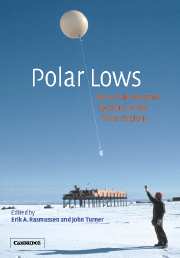2 - Climatology
Published online by Cambridge University Press: 07 December 2009
Summary
The Arctic
Introduction
A large number of the most significant mesoscale vortices/polar lows form in northerly flows close to the Arctic coast or along the ice edges bordering the coast. For this reason, knowledge of the general weather and climatic conditions in the Arctic region is of major importance for an understanding of the formation of mesoscale cyclones, including polar lows.
As explained in Chapter 1, polar lows are a subclass of especially intense, maritime cyclones among the more general mesoscale cyclones. In Scandinavia and elsewhere in northwestern Europe, the main interest for many years has been focused upon the more intense systems, i.e. the polar lows. The term has been widely accepted throughout the meteorological community in the region, even for systems which do not, in a strict sense, fulfil the requirements of a wind speed around or above gale force. For this reason in this section we will generally use the term ‘polar low’ instead of the more general ‘mesoscale cyclone’ or ‘mesocyclone’.
The Arctic region is dominated by the huge, generally sea ice-covered Arctic Ocean. It is approximately as large as the Antarctic continent, but apart from this, there are striking differences between the two regions (see Section 2.2). The Arctic Ocean surrounding the North Pole is bordered by Scandinavia, Siberia, Alaska, Canada and Greenland. It consists of a large basin, the Arctic Ocean, plus a number of marginal seas along the continental shelves.
- Type
- Chapter
- Information
- Polar LowsMesoscale Weather Systems in the Polar Regions, pp. 52 - 149Publisher: Cambridge University PressPrint publication year: 2003
- 5
- Cited by



